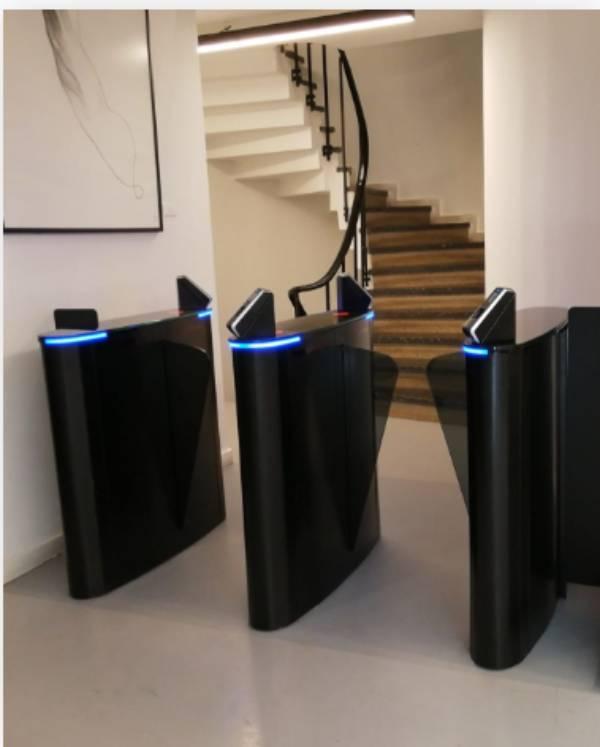What Is a Flap Barrier and Why Is It Used in Public Transit?

A flap barrier is an automated access control system commonly found in transportation terminals, office complexes, and public places. It is intended to control pedestrian traffic and has motorized flaps that open and close quickly, granting or refusing entry depending on authorization. In subway stations—where high volumes of passengers pass in and out during rush hours—flap barriers offer a smooth, efficient means of controlling entry and exit without the use of manual surveillance. Their capacity to balance crowd management, security, and customer convenience makes them a perfect option for transit environments.
How Do Flap Barriers Manage High Foot Traffic in Metro Stations?
Flap barriers are specially designed to handle high-traffic environments such as metro stations. Traditional swing or tripod turnstiles are not designed to do this. Flap barriers, on the other hand, utilize quick-retracting wings that move rapidly and smoothly and minimize bottlenecks even in high-traffic rush hour conditions. With their instant response time of less than a second, they can manage hundreds or thousands of people per hour. Most models also incorporate sensors to sense tailgating or attempts at unauthorized entry, introducing an additional security feature without impeding flow. The high throughput rate of the system allows commuters to pass through without any undue delays.
What Makes Flap Barrier Systems Durable and Reliable?
If they are to be installed in public transport hubs like metro stations, durability is not an option. Flap barriers are made with durable materials such as stainless steel and reinforced polycarbonate that can endure regular use and abuse. The systems are weather-resistant and are engineered to work without any problems over extended periods of time, even in extreme weather conditions. Further, newer models have fail-safe and fail-secure features so that they can still function properly during power failure or system failure. Their dependability in busy-demand environments is one of the main reasons why flap barriers are used in transit areas.
Are Flap Barriers Compliant with Smart Access and Security Technologies?
Flap barrier gates today are not merely physical portals—they are smart systems connected with different access technologies. Metro terminals are served by barriers compatible with RFID cards, QR codes, contactless modes of payment, and biometric readers. This integration facilitates real-time monitoring and access tracking to secure passenger safety and deter fare evasion. Most systems are integrated with central management software, allowing operators to easily collect data, manage flows, and diagnose faults on one easy-to-use interface. This intelligent integration improves both operational performance and user satisfaction.
What Are the Long-Term Benefits of Using Flap Barriers in Metro Stations?
Selecting a flap barrier system for metro stations has a number of long-term benefits. To begin with, these systems greatly minimize the use of manpower at entry and exit points, reducing operational expenses. Secondly, they reduce congestion, enhancing the overall experience of commuters. Thirdly, their integration with smart city infrastructure and future-proof technology means that they are always relevant and scalable as transit systems grow. Over time, flap barriers also enhance data collection and analytics, which help city planners and transit authorities make informed decisions about infrastructure and flow management.
FAQ Section
Can flap barriers detect and prevent unauthorized access?
Yes, modern flap barriers are equipped with infrared sensors and alarms to detect tailgating or unauthorized entry attempts in real time.
Are flap barriers suitable for people with disabilities?
The majority of flap barrier systems come in wide-lane versions to handle wheelchairs and are compliant with accessibility regulations.
How long do flap barrier systems remain operational in metro stations?
Under good maintenance, a good-quality flap barrier system will last 8–10 years or longer even in busy settings.
Are flap barriers compatible with contactless payment systems?
Yes, several flap barrier models are equipped with smart cards, NFC, and QR code-based contactless payment technologies.
What happens to flap barriers during a power failure?
Many flap barriers have a fail-safe mechanism that automatically opens the flaps during a power outage to allow free passage for safety.
Conclusion
In the rapidly changing world of public transport, efficiency and safety are complementary concepts. A flap barrier provides an efficient, intelligent solution for subway stations handling thousands of commuters daily. With their fast operation, sturdy construction, and compatibility with smart access systems, flap barriers satisfy the requirements of high-density areas while promoting safety and user convenience. With the development of urban infrastructure on the rise, these systems are becoming invaluable components of modern transportation networks.
- Art
- Causes
- Crafts
- Dance
- Drinks
- Film
- Fitness
- Food
- Games
- Gardening
- Health
- Home
- Literature
- Music
- Networking
- Other
- Party
- Religion
- Shopping
- Sports
- Theater
- Wellness
- Politics
- IT
- Relationship
- Blockchain
- NFT
- Crypto
- Fintech
- Automobile
- Faith
- Family
- Animals
- Travel
- Pets
- Coding
- Comedy
- Movie
- Game
- Computer



